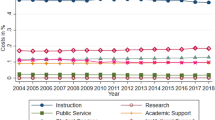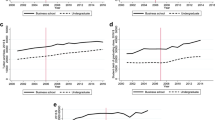Abstract
Under the pressure of sharp budget cuts and external demands for better performance, public institutions of higher education must examine how they can facilitate student graduation even as institutional resources diminish. This paper describes a computer model simulating the movement of undergraduates through a large, public college of business. The model allows changes in curriculum policy, prerequisite structure, and staffing capacity to be tested prior to implementation. Outcome measures focus primarily on the expected time to degree of two types of students who enter the university, first-time freshmen and upper division transfers, along with their respective 6-year and 4-year graduation rates. The validated model is used to experiment with both actual and potential scenarios facing the college and gauge their possible impact.




Similar content being viewed by others
References
Azoury KS, Eng JP and Udayabhanu V (2006). Spreadsheet based simulation framework for enrollment planning. Calif J Opns Mngt 4 (1): 98–104.
Bessent EW and Bessent AM (1980). Student flow in a university department: Results of a Markov analysis. Interfaces 10 (2): 52–59.
Corrigan R and Rosser S (2010). Facilitating Graduation II. A report to the SFSU academic senate, 3 February 2010.
Kelton WD, Sadowski RP and Swets NB (2010). Simulation with Arena. McGraw-Hill: Boston.
Knight WE (2002). Toward a comprehensive model of influences upon time to bachelor′s degree attainment. AIR Professional File 85: 1–15.
Knight WE (2004). Time to bachelor's degree attainment: An application of descriptive, bivariate, and multiple regression techniques. AIR IR Applications 2: 1–15.
Kwak NK, Brown R and Schiederjans MJ (1986). A Markov analysis of estimating student enrollment transition in a trimester institution. Socio Econ Plan 20 (5): 311–318.
Mansmann S and Scholl MH (2007). Decision support system for managing educational capacity utilization. IEEE T Educ 50 (2): 143–150.
Plotnicki WJ and Garfinkel RS (1986). Scheduling academic courses to maximize student flow: A simulation approach. Socio Econ Plan 20 (4): 193–199.
Schellekens A, Paas F, Verbraeck A and van Merriënboer JJG (2010). Designing a flexible approach for higher professional education by means of simulation modelling. J Opl Res Soc 61: 202–210.
SFSU Office of Academic Institutional Research (2010). http://air.sfsu.edu/assessment/prog_rev/univ.html, accessed 4 April 2010.
Shah C and Burke G (1999). An undergrdauate student flow model: Australian higher education. High Educ 37: 359–375.
Simpson WA (1987). Tracking students through majors: Methodology and applications. J High Educ 58 (3): 323–343.
Webster T (1997). Cost analysis and its use in simulation of policy options: The Papua New Guinea education finance model. Int Rev Educ 43 (1): 5–23.
Willett LH (1982). Continuing education student flow analysis. Res High Educ 17 (2): 155–164.
Author information
Authors and Affiliations
Corresponding author
Rights and permissions
About this article
Cite this article
Saltzman, R., Roeder, T. Simulating student flow through a college of business for policy and structural change analysis. J Oper Res Soc 63, 511–523 (2012). https://doi.org/10.1057/jors.2011.59
Received:
Accepted:
Published:
Issue Date:
DOI: https://doi.org/10.1057/jors.2011.59




